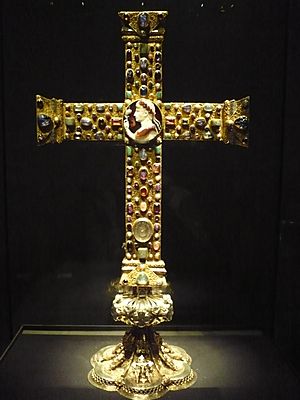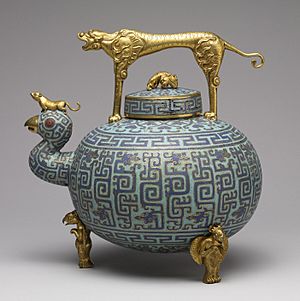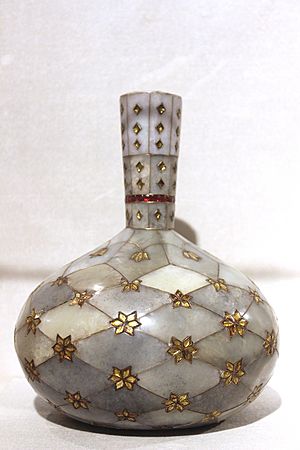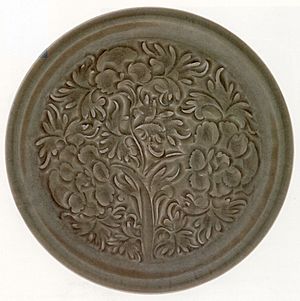Decorative arts facts for kids
The decorative arts are all about making things that are both beautiful and useful! Think of them as crafts where artists design and create everyday objects. This includes things like interior design (making rooms look good), but usually not big buildings like architecture. People often compare decorative arts to "fine arts" like painting, drawing, photography, and big sculpture. Fine arts are usually made just to be admired for their beauty and to make you think, while decorative arts also have a job to do!
Contents
What Makes Decorative Arts Different from Fine Arts?
The idea that decorative arts are different from fine arts mostly started after the Renaissance period in Western art. In many other cultures and times, this difference wasn't as important. In fact, some of the most valuable artworks were decorative!
For example:
- Much of Islamic art uses amazing geometric and plant shapes. These are often found on useful items.
- In Chinese art, the difference isn't very helpful.
- During the Early Middle Ages in Europe, important works were often made from valuable materials like gold, bronze, or carved ivory. Big wall paintings were not as highly thought of back then.
Sometimes, for medieval Christian art made from precious materials, people use the term "ars sacra" (which means "sacred arts").
In the 1970s, some writers and art historians, like Amy Goldin, started to challenge the idea that decoration was "lesser art." By the end of the 20th century, people began to appreciate street art and different cultural decorative styles more. A movement called the 'Pattern and Decoration Movement' in the 1980s also helped people see the value in all kinds of art objects.
How Materials Affect What Survives
Our understanding of art from different cultures can be a bit skewed today. This is because we tend to value fine art materials more. Also, some materials survive much better than others!
- Metal objects, especially those made from valuable metals, were often melted down when they went out of style or when owners needed money. They were like a bank account!
- Illuminated manuscripts (hand-decorated books) have a much higher survival rate. This is especially true for those kept by churches. The materials weren't worth much, and they were easy to store safely.
The Renaissance and Art Values
The idea of "fine arts" being more important than "decorative arts" in Europe largely came from the Renaissance. During this time, Italian thinkers like Giorgio Vasari valued artistic imagination and the unique touch of a master artist like Michelangelo, Raphael, or Leonardo da Vinci. They didn't focus as much on how expensive the materials were or how much skilled work was needed.
Before this, in the Middle Ages, European art often valued expensive materials and amazing skill in difficult techniques.
In China, both ideas existed for a long time:
- Ink and wash painting (often of landscapes) was made by educated officials. It was all about showing the artist's feelings and imagination.
- Other major art forms, like Chinese ceramics (pottery), were made in large workshops. They followed a completely different set of artistic values, focusing on craftsmanship and beauty for everyday use.
The Arts and Crafts Movement

The difference in status between decorative art and fine art started to shrink with the rise of the Arts and Crafts movement. This art movement began in England in the second half of the 19th century. It was inspired by thinkers like William Morris and John Ruskin.
The movement helped people across Europe appreciate decorative arts more. In 1882, the English architect and designer Arthur H. Mackmurdo started the Century Guild for craftsmen. They strongly believed there was no real difference between fine and decorative arts. Many artists and thinkers joined in, helping to spread these new ideas.
Because of the Arts and Crafts movement, decorative arts gained more respect. This even led to changes in the law! Before 1911, only fine art was protected from being copied without permission. The Copyright Act of 1911 changed this, including works of "artistic craftsmanship" in its definition of "artistic work."
Mass Production and Customization
In today's world, with lots of things being mass-produced, people sometimes want to make their belongings unique. They want to show their own lifestyle and identity, even if they buy common items.
One way to make mass-produced objects feel special is to change their look using decorative techniques. This is called customization. Some examples include:
- Decoupage (decorating surfaces with paper cutouts)
- Art cars (cars painted or decorated as art)
- Truck art in South Asia (colorful decorations on trucks)
- IKEA hacking (changing IKEA furniture to make it unique)
Images for kids
-
Le Nove porcelain, Bowl with cover, 1765–70, painted with ruins, soft-paste porcelain
See also
 In Spanish: Artes decorativas para niños
In Spanish: Artes decorativas para niños







